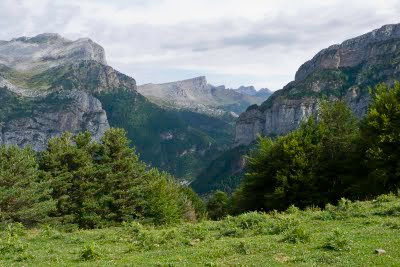The Pyrenees in the Hecho Valley (Photos by Narca)
As we drive into the Hecho Valley in the Pyrenees, nor far from the border between Spain and France, the grand massif rises around us, and wildflowers cloak the slopes. We've arrived at the peak of summer, and it is very, very beautiful.
Hotel Uson, a guesthouse that serves breakfast and dinner
Easy, right? We've allowed three days, just in case.
The Wallcreeper is a Grail bird, with wings that flash maroon, black and white. It occupies a niche unlike any other bird's: it creeps like a nuthatch across the face of immense cliffs. Perhaps it is the combination of rarity, beauty, and lifestyle that so sets it apart from other birds, and makes seeing one an imperative.
We've looked for Wallcreeper in China. We've looked for it in France. We looked for it once before here––just up the road from Hotel Uson, at Boca de Infierno––in spring, when the site lived up to its name, the "Mouth of Hell." We searched then, with no chance of success, in the teeth of a fierce late spring storm which blew sheets of horizontal snow between us and the cliffs frequented by Wallcreepers.
Trail at Gabardito Reserve
Our first morning we set out from Hotel Uson, following the precise directions to the parking area at Gabardito Reserve, only a few miles away. The red and white flagging is obvious, and we follow it, remarking how well-marked the trail is. But the 2-kilometer walk we're expecting seems a lot longer than 2 kilometers! Hours later we finally find a cliff, and it seems remotely to fit the description of The Territory. It is late afternoon, and we've enjoyed flowers, butterflies, and Lammergeiers. We vow to clarify matters and return!
Lammergeier, or Bearded Vulture, a Grail species for many!
Next day a big footrace happens. It turns out, all that flagging was marking the route of the race. Our markers are little peeling rectangles of red and white, painted at rare intervals on rocks.
But our kind hosts have corrected our idea of where to walk, and we return by a much shorter route to yesterday's cliff, and continue a little further around it. There indeed is the Wallcreeper Cleft-in-the-Cliff––and there is the Wallcreeper! It has been worth every hour of effort over the years!
A Wallcreeper territory
The Wallcreeper frequents a deep cleft in the cliff face. He forages around plants that cling to a precarious perch, and we think we see the location of the nest, as he returns occasionally bearing food. Once he chases the kestrel that is nesting nearby on the same massive rock wall. Once two Wallcreepers are visible.
A female Common Kestrel approaches her nest, showing warm tones in her tail.
The Wallcreepers come and go on foraging forays. They appear tiny on the gray immensity of the cliff face. We spend hours savoring them––and their environs.
Red-billed Choughs also nest nearby.
Griffon Vulture
Griffon Vultures, Red-billed Choughs, Alpine Swifts, Crag Martins, and Lammergeiers all soar overhead.
Coal Tit, a cousin to our chickadees
A Coal Tit hammers on a seed. The very air sparkles. We find an immense lily, which I'm still trying to identify. Butterflies are abundant. (I'll do a separate post on them!)
You'd probably enjoy seeing what a Wallcreeper looks like. I've added an arrow to help. They aren't easy to find, are they?
The Grail (Computer-enhanced Pen & Ink by Narca)











































